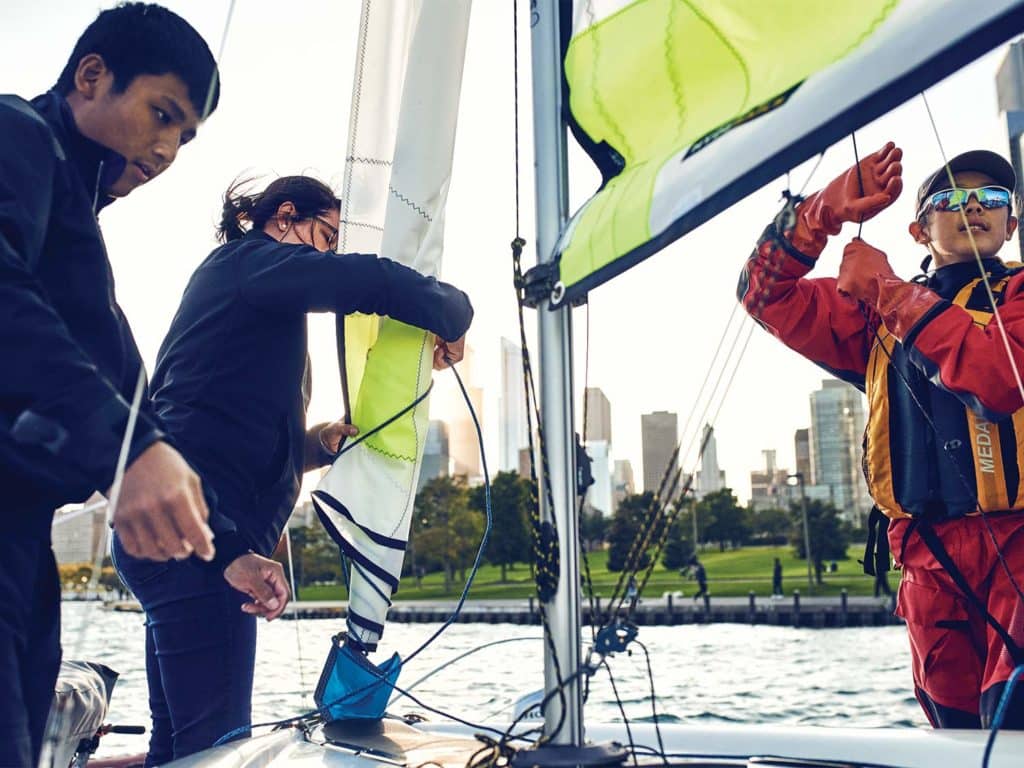
Events in 2020 laid bare a host of societal shortcomings. Inspiration says we must take action. In the next minute, the cynic in me shouts out that suddenly every institution from Harvard to your local YC to Gus’ Gas and Bait Shop now has a DE&I committee. Some, but I hope not all, will fritter away to mere talk. But in case you missed it, DE&I stands for diversity, equity and inclusion. Diversity means that everybody gets invited to the dance. Equity means that everybody gets to dance. Inclusion means that everybody has a good time. There has never been a better time to talk about this. Ordinarily, it would be outside the view of a racing-sailing magazine to broach these topics, but the fact is, the country we live in is jangled. We’re poised for a reset.
“US Sailing has 1,700 member organizations,” president Cory Sertl says. “In this moment, they’re coming to us for advice, and bringing with them a willingness and desire to diversify their memberships. That’s true whether they’re a prestigious yacht club, a community sailing center or an off-the-beach just-do-it.”
But how? How to go from good intentions to effective action. Writing this column was an education as I phone-walked my way through operations that are already fully engaged. They have lessons to teach. Take Karen Harris in Chicago, for example: Her 125-year-old Jackson Park Yacht Club on the South Side of the city is sited in a target-rich environment, if you’re talking DE&I opportunity. The surrounding community houses a large population of minority families, and the facility is suited to teaching beginners; it even works day by day for hosting caregivers who cannot afford to travel back and forth twice, to drop off and pick up (two bus fares for grandma versus four).
The only ingredients missing when Harris became commodore were initiative and commitment. She brought those. Harris says: “The club’s junior program was defunct, so we started from scratch and ran a conventional program the first year. In 2018, we became a 501c3, acquired grant money, and launched outreach.”
In summer programs that attract some 250 kids, there is scholarship funding for those who need it, and the demographic skews slightly toward minorities. So too does the staff, “but you have to literally grow that staff,” Harris says. “Our instructor-in-training program is for kids 13 to 15 who are mature, talented and play well with others. We waive their fees, and they shadow the certified instructors as an extra pair of hands until they’re ready for Level 1 training. When they pass the tests, I have another instructor I can hire.”
To date, that effort has produced three Level 1 instructor/role models. Harris says: “I hired them all, and we have another four in the pipeline. It’s only a matter of time before I can’t hire all the minority instructors we turn out. I want to see them fanning out and working all over the place.”
Even when they tell their teachers (as teachers often tell us), “That was the best day ever,” they might not find their way back.
Go ahead, Karen. Make me jealous. One of the truisms of community sailing is that each location is unique. At San Francisco’s Treasure Island Sailing Center, where I serve on a DE&I working group, we have direct access to every fourth and fifth grader in the San Francisco Unified School District, but they do not have direct access to us. That is, every fourth and fifth grader is bused to TISC for a day of experiential learning, a little time in a boat and, for many, a first-time opportunity to trail a finger in the water or scrunch a toe in wet sand. Then they’re back to their lives on the other side of a very big bridge and, in many cases, to the other-other side of a large, complicated city. Even when they tell their teachers (as teachers often tell us), “That was the best day ever,” they might not find their way back. There is no straight path for them to grow into middle school instructors-in-training. In the summer, TISC attracts a diverse population of 300 kids. Some of them return after finding us through SFUSD (San Francisco Unified School District), but they have not, historically, become our certified junior instructors. We’re working on that. We want a cadre of Black, Latinx and Asian instructors for their value as role models—to bring the next group along—but also for their own sakes. Too many kids don’t know, and their parents don’t know, that there is a path to teenage jobs in the fresh air, developing responsibility, management skills and emotional intelligence—a path that opens doors. Perhaps I mentioned, we’re working on it.
Back on the shores of Lake Michigan, Harris has this to add about her working reality: “Chicago has 2 million people, but 800,000 of them have never even seen the lake. We get kids who think it’s the ocean, and they’re afraid of sharks. For that and for all the steps that follow, we have a clinical sports psychologist on-site to deal with anxieties, tensions and conflict resolution.”
So we see that good intentions are not enough. In New York at the Hudson River Sailing Center, many of the employees are also former students. The program looks for schools within bike-riding distance and selects middle school populations from schools with the highest percentage of kids who depend upon funded lunches. US Sailing vice president Rich Jepsen calls it “a social justice program as much as a sailing program,” and Hudson River’s Maeve Gately agrees [Correction: Ms. Maeve states for the record, “We are a youth development program—though we work with students of color, that does not make us a social justice organization. The distinction is important.”—Ed].
“We close the achievement gap by providing a transformative experience,” Gately says. “Younger students build boats in the winter, which is a hands-on geometry lesson. In the spring, they launch and invite their parents to celebrate the accomplishment. We teach the math and science of sailing, meaning we teach math and science. Also engine maintenance, sail repair, bookkeeping. In our last class, 98 percent of the kids went on to college. Some continue as sailors, and we like that, but it’s not our metric of success. Sailing is our platform for developing life skills.”
Up to this point, I’ve been writing about pathways for minorities and the underprivileged, but that’s only one dimension of the big picture. Sertle says: “Bringing women into the sport, and advancing them as coaches, is important. Developing metrics for measuring progress is important—and getting adaptive sailing back into the Paralympics.”

George Washington University’s sailing team captain John DeRuff points to growth opportunities among “LGBTQ kids who participate in sports at a lower rate than straight kids,” drop out more often, and hide the feelings and fears that drive those decisions while burying their potential as leaders. In a world less screwed up, I could name names, but I’ll stop with that name, because DeRuff came out as a leader in a time when college sailing now has TIDE, which is The Inclusivity, Diversity and Equity taskforce.
In Jepsen’s long view, “DE&I matters were on our radar for a while. US Sailing finally formed a DE&I committee two years ago at the behest of the US Olympic Paralympic Committee, then everything ramped up with the social-justice crises of 2020.”
Add to that, I wrote about the Siebel Sailors Program this past spring, when it was ready to go large, right before we all got 2020′d and well before the streets were convulsed with protests. Funded by tech entrepreneur Tom Siebel in partnership with US Sailing, the program supports community sailing hubs in cities across the US, providing boats and coaching—high-level coaching which, for beginners, is rare.
Siebel program manager Blair Overman relates that during the pandemic, activity levels across the country varied from medium to sparse, but the time has not gone to waste. In the launch, there have been surprises for instructors who are used to kids who have never sailed but not to kids who have never waded in water to their knees. They’ve had to adjust. Many programs have been forced to crank up even greater creativity in how to get kids to their facilities. And the hallmark of the Siebel Sailors’ evolving curriculum—food—is validated. “Every time the kids come,” Overman says, “food is reinforcing, even to a kid who isn’t really, really hungry, but we get kids who are really, really hungry. Until they’re fueled, you can’t expect them to put up a best effort.
“We emphasize basic needs,” Overman continues. “We emphasize a welcoming, comfortable environment. We emphasize empowering students by giving them choices in at least one activity each day, something they can make their own. But executing on that? It’s hard. It has to be intentional, and it has to happen every day. We saw some coaches doing this instinctively, and they were getting the best results, so over the winter we invested time in training all of our coaches to their habits.”
The Siebel Sailors Program distributes its benefits through community sailing programs in every region of the country, and expansion is the mantra: reaching more kids. “You have to know that it can scale,” Siebel says. “My hope is that in 10 years, this will be transformative. Sailing is magical.” Magical, the man means, in changing lives in positive ways.
My report. From a few strongholds in the land of believers.









